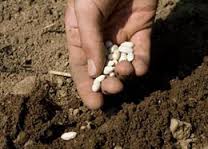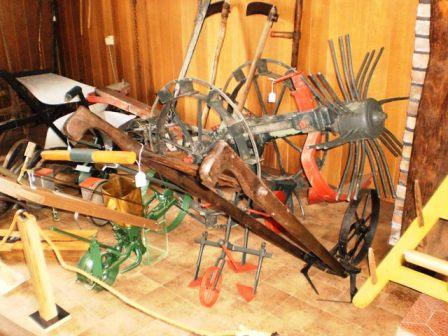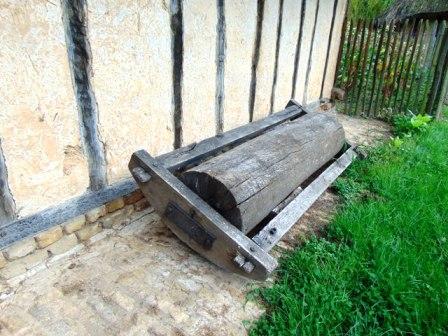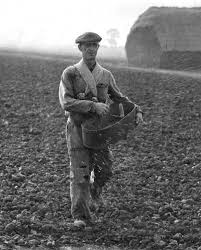 To sow, sprinkle some matured compost in a gully - if you have some. Then the seeds. Not too close together, each plant needs enough space. Sprinkle soil over the seed, about three times the thickness of the seed. Ensure that the soil and the seeds do not dry out.
To sow, sprinkle some matured compost in a gully - if you have some. Then the seeds. Not too close together, each plant needs enough space. Sprinkle soil over the seed, about three times the thickness of the seed. Ensure that the soil and the seeds do not dry out.
Keep the distance between the rows such that the mature plants just touch each other (and so remove light between the rows that weeds need to grow).
Root vegetables (carrots, parsnips, parsley, beets) may in line close together,
Leeks and cabbage are also sown so, and afterwards planted apart.
Plants that are too close together you can carefully dig out and replant. Provide adequate water, especially in the beginning. Many fine hair roots will be torn, and the few that remain have to keep the plant alive.
 Some plants have a favorable influence on each other, e.g. because they keep away each other's enemies. Onion and carrot are a known combination.
Some plants have a favorable influence on each other, e.g. because they keep away each other's enemies. Onion and carrot are a known combination.
Marigold fights root lesion nematode (but encourage other species as Trichodoridae).
Sticky nightshade ( Solanum sisymbriifolium) combats the potato cyst nematode.
Provide plenty of variety, so that already infected plants not infect others. Make lots of varied short rows rather than one big uniform field.
Most crops have early and late varieties. You can so better spread sowing, planting and harvesting for vb. tomatoes, strawberries, leek, carrot, etc.
I usually put my rake on the ground to make a gully next to the stem. The short rows are subsequently easy to weed or hoeing from the intermediate footpath. For longer lines, you can use a rope.
Beginning and end of the row your highlight best. I use two sticks prunings or coarse compost for this, or just radish seeds: it germinates and grows very quickly. So you see, even before something comes out, where the rows run, and you can keep the germinating seeds moist. If it is completely dry, it is of course death.
You can accelerate the seeds to germs by soaking them for 24 hours in lukewarm water. The sowing is less easily. It would germinate faster if you mix a pinch of honey in the water. (I never tested.)
See also <Greenhouse> for sowing, harden off and transplant.
Some roots go into depth. Roots grow and branch out constantly, looking for suitable moisture and nutrients. There are always formed new hair roots, which operate approximately 1 week.
 For larger plots with green manure, grass or grain can either sow broadcasting. With handfuls try to scatter the seed as evenly as possible over the entire plot. Then just rake it in so there is some ground cover, and some pressing with a roller (or over walking with boards tied beneath your feet). Given much seed remains exposed therefore you better place a scarecrow, or some stakes slope stabbed into the ground with swirling ribbons and gleaming aluminum containers. Make sure that it moves in the wind and makes a noise, and it does not look the same every day. Otherwise, much of your harvest is gone before it has germinated.
For larger plots with green manure, grass or grain can either sow broadcasting. With handfuls try to scatter the seed as evenly as possible over the entire plot. Then just rake it in so there is some ground cover, and some pressing with a roller (or over walking with boards tied beneath your feet). Given much seed remains exposed therefore you better place a scarecrow, or some stakes slope stabbed into the ground with swirling ribbons and gleaming aluminum containers. Make sure that it moves in the wind and makes a noise, and it does not look the same every day. Otherwise, much of your harvest is gone before it has germinated.
Broadcast sowing you can best practice and exercise a while in advance with some less costly lime or compost. I’m right handed, so I wear the bucket with seeds against my left hip, the opening diagonally to my right shoulder. For large plots I use a broad belt over my right shoulder, under my left arm, and hang the handle to a snap. Because such a bucket is heavy after a while! (A belt or strap is comfortable, thin rope cuts.)
Seeding is a matter of feeling and cadence. I start with the right, and every step is also consistent with an arm movement: grab seed, briefly dropping to the right and another portion of the seed you let slip through your fingers while swinging wide to the left, and sprinkle the rest. And so on. If you practice with lime on grass you see well marked where every spot ends up, and you can adjust step size and speed, and throwing technique until you get a good coverage. By going into long strips on and off, you can also overlap when needed.
If you consume too much precious seed by sprinkling too close together, you can pre- mix with dry sand or lime.
Then harrows to distribute the seed and get better spread in rows, and have some cover to.
 A seed fiddle is a container (worn on the abdomen) with at the bottom an adjustable slider opening through which the seed falls on a horizontal paddle wheel. That runs through moving a stick back and forth. This movement is transmitted to the axle of the wheel via a rope or belt This will scatter and fairly regularly thrown the broadcasted seed.
A seed fiddle is a container (worn on the abdomen) with at the bottom an adjustable slider opening through which the seed falls on a horizontal paddle wheel. That runs through moving a stick back and forth. This movement is transmitted to the axle of the wheel via a rope or belt This will scatter and fairly regularly thrown the broadcasted seed.
This willscatter andfairly regularlythrown the broadcasted seed.
Some birds pecking on seedlings. Short sticks around the seedbed with black thread crisscrossing the seedbed can provide protection. Or a net.
Baptism principle
Many gardeners swear by the principle of non - watering. At sowing or planting they give water once, and leave the rest to nature. That forces the crop to invest in a sturdy root growth, so they can always reach water. By continuing to provide water, you get little and lazy roots, and plants wither as they are little irrigated. They claim even in hot and dry summers (with ground cover) to maintain firm vegetables and plants without watering.
It makes sense, in nature, there it is like that. But I think there is nothing wrong with keeping a close eye on the case and steer it as necessary. (Especially with plants in pots and boxes.)
Mid-July, I found a nice strawberry field that was not picked. Feasted on delicious. Three days later I went back to see if there (possibly with consent could be harvested. There were still plenty of strawberries, but they clearly were not worth picking costs. And unfortunately, that’s why was the (underground) irrigation system was switched off. Making only some unsavory, dried fruits. In 3 days. While my non-irrigated shrubs home were still fresh and green in the same sun.
